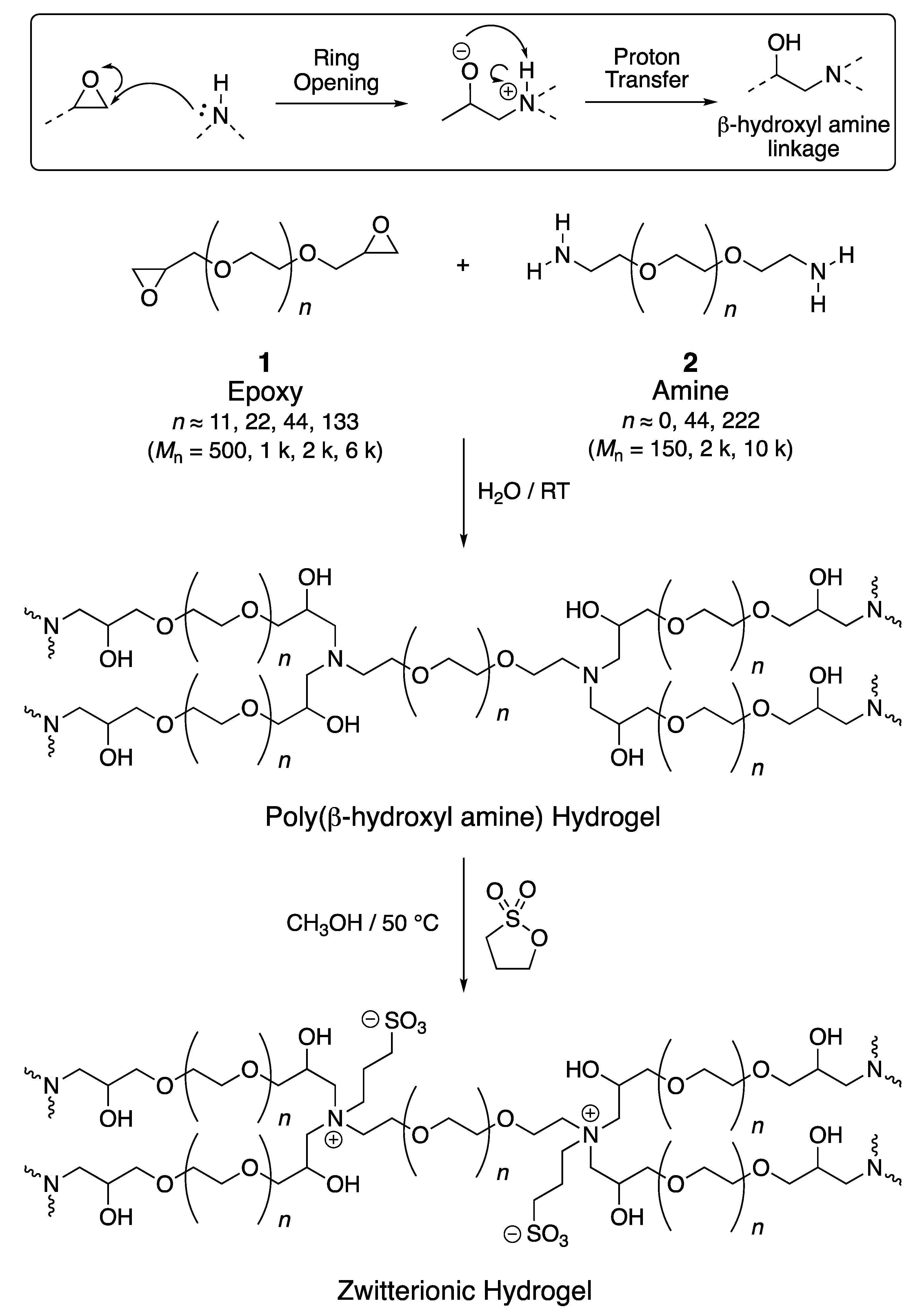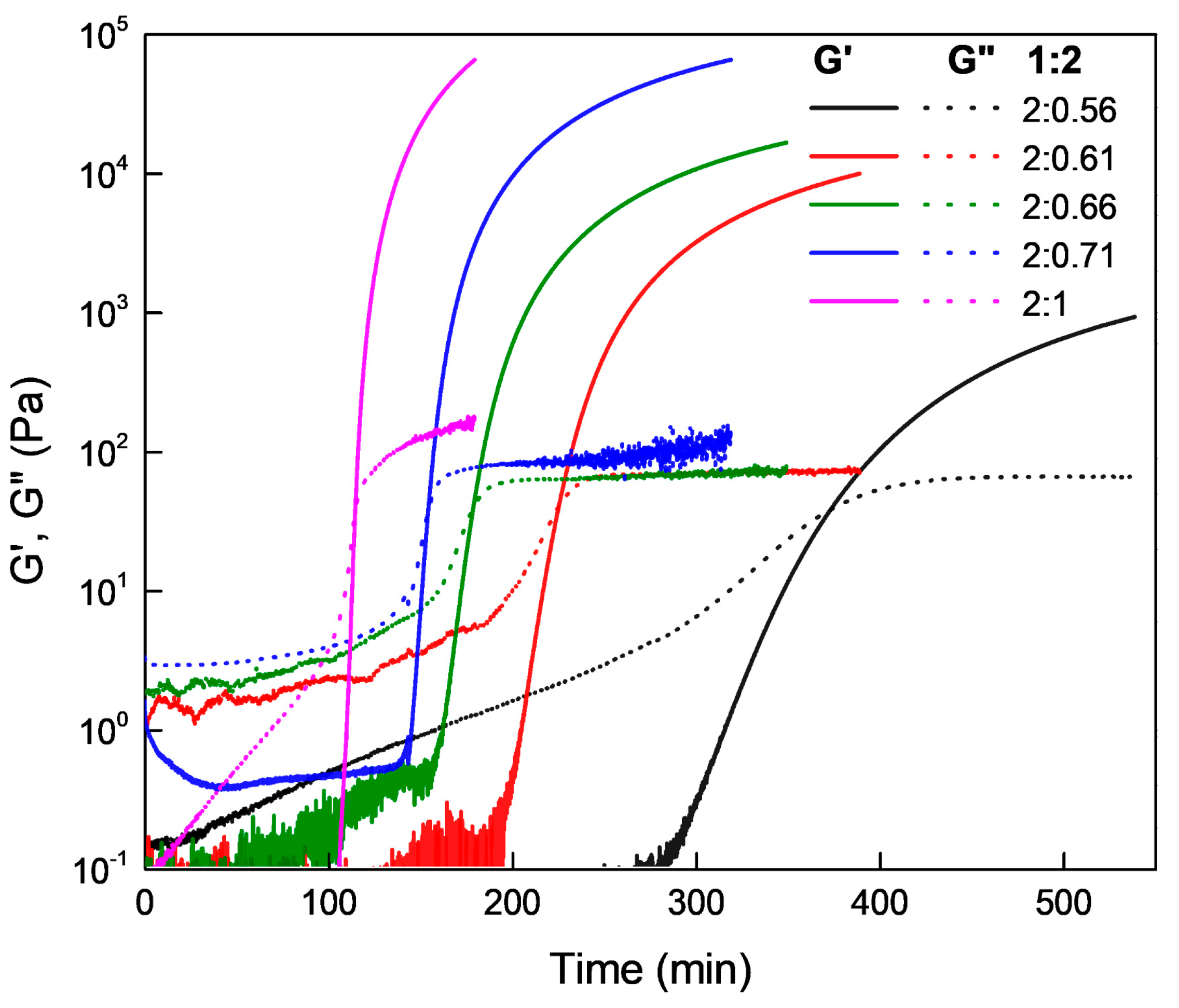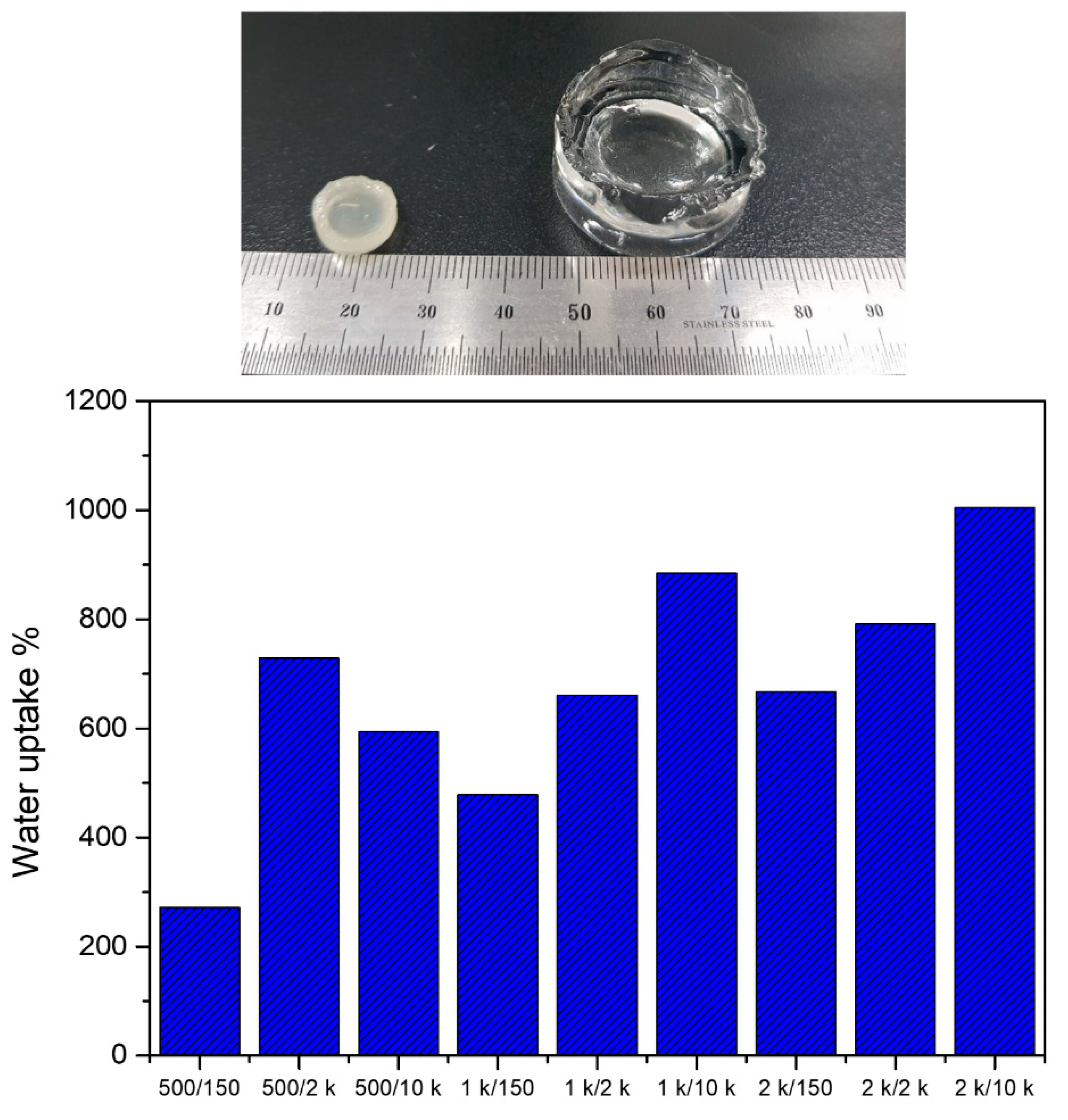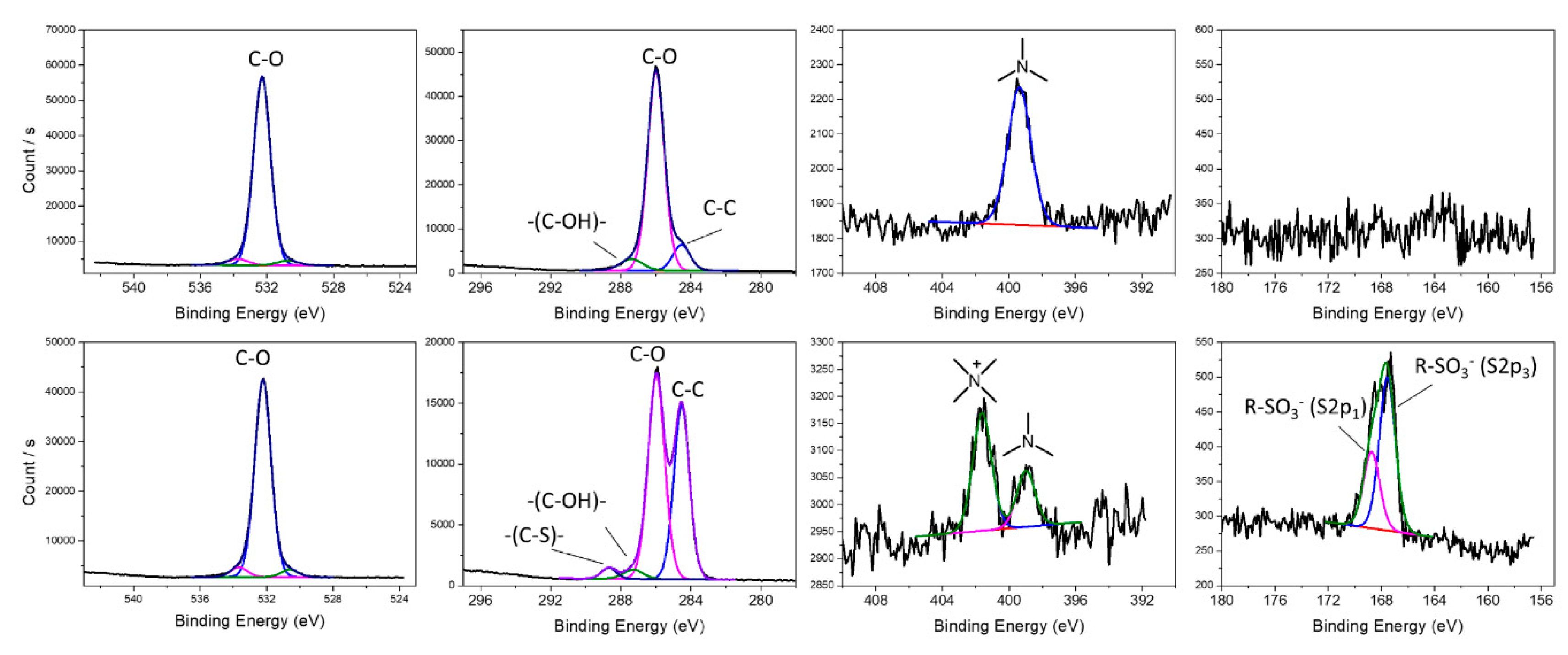A Modular and Practical Synthesis of Zwitterionic Hydrogels through Sequential Amine-Epoxy “Click” Chemistry and N-Alkylation Reaction
Abstract
:1. Introduction
2. Materials and Methods
2.1. Experimental Details
2.2. Gel Functionalization
2.3. Preparation of Hydrogels
2.4. Rheological Characterization
2.5. Mechanical Tests
2.6. Swelling Studies
2.7. Thermogravimetric Analysis
2.8. Protein Adsorption on the Hydrogel
2.9. MIMIC Lithography
3. Results and Discussion
4. Conclusions
Supplementary Materials
Author Contributions
Acknowledgments
Conflicts of Interest
References
- Muzammil, E.M.; Khan, A.; Stuparu, M.C. Post-polymerization modification reactions of poly (glycidyl methacrylate)s. RSC Adv. 2017, 7, 55874–55884. [Google Scholar] [CrossRef]
- Stuparu, M.C.; Khan, A. Thiol-epoxy “click” chemistry: Application in preparation and postpolymerization modification of polymers. J. Polym. Sci. A 2016, 54, 3057–3070. [Google Scholar] [CrossRef]
- Chang, H.-T.; Fréchet, J.M. Proton-transfer polymerization: A new approach to hyperbranched polymers. J. Am. Chem. Soc. 1999, 121, 2313–2314. [Google Scholar] [CrossRef]
- Emrick, T.; Chang, H.-T.; Frechet, J.M. An A2+ B3 approach to hyperbranched aliphatic polyethers containing chain end epoxy substituents. Macromolecules 1999, 32, 6380–6382. [Google Scholar] [CrossRef]
- Gong, C.; Fréchet, J.M. Proton transfer polymerization in the preparation of hyperbranched polyesters with epoxide chain-ends and internal hydroxyl functionalities. Macromolecules 2000, 33, 4997–4999. [Google Scholar] [CrossRef]
- Hecht, S.; Emrick, T.; Fréchet, J.M. Hyperbranched porphyrins—A rapid synthetic approach to multiporphyrin macromolecules. Chem. Commun. 2000, 313–314. [Google Scholar] [CrossRef]
- Emrick, T.; Chang, H.-T.; Fréchet, J.M.; Woods, J.; Baccei, L. Hyperbranched aromatic epoxies in the design of adhesive materials. Polym. Bull. 2000, 45, 1–7. [Google Scholar] [CrossRef]
- Lee, B.F.; Kade, M.J.; Chute, J.A.; Gupta, N.; Campos, L.M.; Fredrickson, G.H.; Kramer, E.J.; Lynd, N.A.; Hawker, C.J. Poly (allyl glycidyl ether)-A versatile and functional polyether platform. J. Polym. Sci. A 2011, 49, 4498–4504. [Google Scholar] [CrossRef]
- Herzberger, J.; Niederer, K.; Pohlit, H.; Seiwert, J.; Worm, M.; Wurm, F.R.; Frey, H. Polymerization of ethylene oxide, propylene oxide, and other alkylene oxides: Synthesis, novel polymer architectures, and bioconjugation. Chem. Rev. 2015, 116, 2170–2243. [Google Scholar] [CrossRef]
- Brändle, A.; Khan, A. Thiol–epoxy ‘click’polymerization: Efficient construction of reactive and functional polymers. Polym. Chem. 2012, 3, 3224–3227. [Google Scholar] [CrossRef]
- Cengiz, N.; Rao, J.; Sanyal, A.; Khan, A. Designing functionalizable hydrogels through thiol–epoxy coupling chemistry. Chem. Commun. 2013, 49, 11191–11193. [Google Scholar] [CrossRef]
- Gadwal, I.; Binder, S.; Stuparu, M.C.; Khan, A. Dual-reactive hyperbranched polymer synthesis through proton transfer polymerization of thiol and epoxide groups. Macromolecules 2014, 47, 5070–5080. [Google Scholar] [CrossRef]
- Binder, S.; Gadwal, I.; Bielmann, A.; Khan, A. Thiol-epoxy polymerization via an AB monomer: Synthetic access to high molecular weight poly (β-hydroxythio-ether) s. J. Polym. Sci. A 2014, 52, 2040–2046. [Google Scholar] [CrossRef]
- Hwang, J.; Choe, Y.; Bang, J.; Khan, A. Scalable ambient synthesis of water-soluble poly (β-hydroxythio-ether) s. J. Polym. Sci. A 2017, 55, 3381–3386. [Google Scholar] [CrossRef]
- Hwang, J.; Lee, D.G.; Yeo, H.; Rao, J.; Zhu, Z.; Shin, J.; Jeong, K.; Kim, S.; Jung, H.W.; Khan, A. Proton transfer hydrogels: Versatility and applications. J. Am. Chem. Soc. 2018, 140, 6700–6709. [Google Scholar] [CrossRef]
- Kolb, H.C.; Finn, M.; Sharpless, K.B. Click chemistry: Diverse chemical function from a few good reactions. Angew. Chem. 2001, 40, 2004–2021. [Google Scholar] [CrossRef]
- Ren, Y.; Jiang, X.; Yin, J. Poly (ether tert-amine): A novel family of multiresponsive polymer. J. Polym. Sci. A 2009, 47, 1292–1297. [Google Scholar] [CrossRef]
- Saha, A.; De, S.; Stuparu, M.C.; Khan, A. Facile and general preparation of multifunctional main-chain cationic polymers through application of robust, efficient, and orthogonal click chemistries. J. Am. Chem. Soc. 2012, 134, 17291–17297. [Google Scholar] [CrossRef]
- Si, G.; Elzes, M.; Engbersen, J.; Paulusse, J. Modular synthesis of bioreducible gene vectors through polyaddition of N, N′-dimethylcystamine and diglycidyl ethers. Polymers 2018, 10, 687. [Google Scholar] [CrossRef]
- Li, D.; Bu, Y.; Zhang, L.; Wang, X.; Yang, Y.; Zhuang, Y.; Yang, F.; Shen, H.; Wu, D. Facile construction of pH-and redox-responsive micelles from a biodegradable poly (β-hydroxyl amine) for drug delivery. Biomacromolecules 2015, 17, 291–300. [Google Scholar] [CrossRef]
- Sun, G.; Liu, J.; Wang, X.; Li, M.; Cui, X.; Zhang, L.; Wu, D.; Tang, P. Fabrication of dual-sensitive poly (β-hydroxyl amine) micelles for controlled drug delivery. Eur. Polym. J. 2019, 114, 338–345. [Google Scholar] [CrossRef]
- Su, Z.; Jiang, X. Multi-stimuli responsive amine-containing polyethers: Novel building blocks for smart assemblies. Polymer 2016, 93, 221–239. [Google Scholar] [CrossRef]
- Yu, J.; Su, Z.; Xu, H.; Ma, X.; Yin, J.; Jiang, X. One-pot approach to synthesize hyperbranched poly (thiol–ether amine)(hPtEA) through sequential “thiol–ene” and “epoxy–amine” click reactions. Polym. Chem. 2015, 6, 6946–6954. [Google Scholar] [CrossRef]
- Xu, L.Q.; Pranantyo, D.; Neoh, K.-G.; Kang, E.-T.; Teo, S.L.-M.; Fu, G.D. Synthesis of catechol and zwitterion-bifunctionalized poly (ethylene glycol) for the construction of antifouling surfaces. Polym. Chem. 2016, 7, 493–501. [Google Scholar] [CrossRef]
- Drury, J.L.; Mooney, D.J. Hydrogels for tissue engineering: Scaffold design variables and applications. Biomaterials 2003, 24, 4337–4351. [Google Scholar] [CrossRef]
- Hoare, T.R.; Kohane, D.S. Hydrogels in drug delivery: Progress and challenges. Polymer 2008, 49, 1993–2007. [Google Scholar] [CrossRef] [Green Version]
- Grinstaff, M.W. Dendritic macromers for hydrogel formation: Tailored materials for ophthalmic, orthopedic, and biotech applications. J. Polym. Sci. A 2008, 46, 383–400. [Google Scholar] [CrossRef]
- Slaughter, B.V.; Khurshid, S.S.; Fisher, O.Z.; Khademhosseini, A.; Peppas, N.A. Hydrogels in regenerative medicine. Adv. Mater. 2009, 21, 3307–3329. [Google Scholar] [CrossRef]
- Shoichet, M.S. Polymer scaffolds for biomaterials applications. Macromolecules 2009, 43, 581–591. [Google Scholar] [CrossRef]
- DeForest, C.A.; Anseth, K.S. Advances in bioactive hydrogels to probe and direct cell fate. Annu. Rev. Chem. Biomol. Eng. 2012, 3, 421–444. [Google Scholar] [CrossRef]
- Malkoch, M.; Vestberg, R.; Gupta, N.; Mespouille, L.; Dubois, P.; Mason, A.F.; Hedrick, J.L.; Liao, Q.; Frank, C.W.; Kingsbury, K. Synthesis of well-defined hydrogel networks using click chemistry. Chem. Commun. 2006, 2774–2776. [Google Scholar] [CrossRef]
- Yigit, S.; Sanyal, R.; Sanyal, A. Fabrication and functionalization of hydrogels through “click” chemistry. Chem. Asian J. 2011, 6, 2648–2659. [Google Scholar] [CrossRef]
- Nimmo, C.M.; Shoichet, M.S. Regenerative biomaterials that “click”: Simple, aqueous-based protocols for hydrogel synthesis, surface immobilization, and 3D patterning. Bioconjugate Chem. 2011, 22, 2199–2209. [Google Scholar] [CrossRef]
- Azagarsamy, M.A.; Anseth, K.S. Bioorthogonal Click Chemistry: An Indispensable Tool to Create Multifaceted Cell Culture Scaffolds; ACS Publications: Washington, DC, USA, 2012. [Google Scholar]
- Cengiz, N.; Gevrek, T.; Sanyal, R.; Sanyal, A. Orthogonal thiol–ene ‘click’reactions: A powerful combination for fabrication and functionalization of patterned hydrogels. Chem. Commun. 2017, 53, 8894–8897. [Google Scholar] [CrossRef]
- Gevrek, T.N.; Cosar, M.; Aydin, D.; Kaga, E.; Arslan, M.; Sanyal, R.; Sanyal, A. Facile fabrication of a modular “catch and release” hydrogel interface: Harnessing thiol–disulfide exchange for reversible protein capture and cell attachment. ACS Appl. Mater. Interfaces 2018, 10, 14399–14409. [Google Scholar] [CrossRef]
- Arslan, M.; Gevrek, T.N.; Sanyal, R.; Sanyal, A. Fabrication of poly (ethylene glycol)-based cyclodextrin containing hydrogels via thiol-ene click reaction. Eur. Polym. J. 2015, 62, 426–434. [Google Scholar] [CrossRef]
- Park, E.J.; Gevrek, T.N.; Sanyal, R.; Sanyal, A. Indispensable platforms for bioimmobilization: Maleimide-based thiol reactive hydrogels. Bioconjugate Chem. 2014, 25, 2004–2011. [Google Scholar] [CrossRef]
- Beria, L.; Gevrek, T.N.; Erdog, A.; Sanyal, R.; Pasini, D.; Sanyal, A. ‘Clickable’hydrogels for all: Facile fabrication and functionalization. Biomater. Sci. 2014, 2, 67–75. [Google Scholar] [CrossRef]
- Kaga, S.; Yapar, S.; Gecici, E.M.; Sanyal, R. Photopatternable “clickable” hydrogels: “Orthogonal” control over fabrication and functionalization. Macromolecules 2015, 48, 5106–5115. [Google Scholar] [CrossRef]
- Hamid, Z.A.; Blencowe, A.; Ozcelik, B.; Palmer, J.A.; Stevens, G.W.; Abberton, K.M.; Morrison, W.A.; Penington, A.J.; Qiao, G.G. Epoxy-amine synthesised hydrogel scaffolds for soft-tissue engineering. Biomaterials 2010, 31, 6454–6467. [Google Scholar] [CrossRef]
- Ozcelik, B.; Brown, K.D.; Blencowe, A.; Daniell, M.; Stevens, G.W.; Qiao, G.G. Ultrathin chitosan–poly (ethylene glycol) hydrogel films for corneal tissue engineering. Acta Biomater. 2013, 9, 6594–6605. [Google Scholar] [CrossRef] [PubMed]
- Stevens, L.; Calvert, P.; Wallace, G.G. Ionic-covalent entanglement hydrogels from gellan gum, carrageenan and an epoxy-amine. Soft Matter 2013, 9, 3009–3012. [Google Scholar] [CrossRef] [Green Version]
- Krüger, A.J.; Köhler, J.; Cichosz, S.; Rose, J.C.; Gehlen, D.B.; Haraszti, T.; Möller, M.; De Laporte, L. A catalyst-free, temperature controlled gelation system for in-mold fabrication of microgels. Chem. Commun. 2018, 54, 6943–6946. [Google Scholar] [CrossRef] [PubMed]
- Zhou, C.; Truong, V.X.; Qu, Y.; Lithgow, T.; Fu, G.; Forsythe, J.S. Antibacterial poly (ethylene glycol) hydrogels from combined epoxy-amine and thiol-ene click reaction. J. Polym. Sci. A 2016, 54, 656–667. [Google Scholar] [CrossRef]
- Liu, Z.; Zhang, C.; Xu, H.; Ma, X.; Shi, Z.; Yin, J. A Facile Method Synthesizing Hydrogel Using Hybranched Polyether Amine (hPEA) as Coinitiator and Crosslinker. Macromol. Chem. Phys. 2017, 218, 1700251. [Google Scholar] [CrossRef]
- Zhang, C.; Liu, Z.; Zhang, X.; Shi, Z.; Xu, H.; Ma, X.; Yin, J.; Tian, M. Polyetheramine (PEA): A versatile platform to tailor the properties of hydrogels via H-bonding interactions. Polym. Chem. 2017, 8, 5367–5373. [Google Scholar] [CrossRef]
- Bakarich, S.E.; Balding, P.; Gorkin III, R.; Spinks, G.M. Printed ionic-covalent entanglement hydrogels from carrageenan and an epoxy amine. RSC Adv. 2014, 4, 38088–38092. [Google Scholar] [CrossRef] [Green Version]
- Ding, J.; Zhou, C.; Li, K.; Zhang, A.; Yao, F.; Xu, L.; Fu, G. Preparation of well-defined fibrous hydrogels via electrospinning and in situ “click chemistry”. RSC Adv. 2016, 6, 27871–27878. [Google Scholar] [CrossRef]
- Qian, S.; Zhou, C.; Xu, L.; Yao, F.; Cen, L.; Fu, G. High strength biocompatible PEG single-network hydrogels. RSC Adv. 2014, 4, 25241–25250. [Google Scholar] [CrossRef]
- Liu, S.; Oderinde, O.; Hussain, I.; Yao, F.; Fu, G. Dual ionic cross-linked double network hydrogel with self-healing, conductive, and force sensitive properties. Polymer 2018, 144, 111–120. [Google Scholar] [CrossRef]
- Lin, C.-C.; Anseth, K.S. PEG hydrogels for the controlled release of biomolecules in regenerative medicine. Pharm. Res. 2009, 26, 631–643. [Google Scholar] [CrossRef] [PubMed]
- Zhu, J. Bioactive modification of poly (ethylene glycol) hydrogels for tissue engineering. Biomaterials 2010, 31, 4639–4656. [Google Scholar] [CrossRef] [PubMed]
- Bakaic, E.; Smeets, N.M.; Hoare, T. Injectable hydrogels based on poly (ethylene glycol) and derivatives as functional biomaterials. RSC Adv. 2015, 5, 35469–35486. [Google Scholar] [CrossRef]
- Kim, E.; Xia, Y.; Whitesides, G.M. Polymer microstructures formed by moulding in capillaries. Nature 1995, 376, 581. [Google Scholar] [CrossRef]










| Entry | 1/2 | 1/2 (g) | Molar Ratio (1:2) | Solvent (mL) | Gel Formation (R.T) | Gel Formation (70 °C) | Rotational Rheometer (70 °C) | Young′s Modulus (kPa) |
|---|---|---|---|---|---|---|---|---|
| 1 | 500/150 | 0.1/0.0015 | 2:1 | H2O (0.115) | 2.5–3 h | 10 min | 4 min | 1575 |
| 2 | 500/2k | 0.05/0.1 | 2:1 | H2O (0.15) | 2.5–3 h | 20–30 min | 13 min | 659 |
| 3 | 500/10k | 0.01/0.1 | 2:1 | H2O (0.11) | −12 h | 1–2 h | 3 h | 96 |
| 4 | 1k/150 | 0.1/0.0075 | 2:1 | H2O (0.1075) | 3–4 h | 10–20 min | 10 min | 663 |
| 5 | 1k/2k | 0.05/0.05 | 2:1 | H2O (0.1) | 5–6 h | 20–30 min | 18 min | 571 |
| 6 | 1k/10k | 0.02/0.1 | 2:1 | H2O (0.12) | −12 h | 1–2 h | 3 h | 117 |
| 7 | 2k/150 | 0.1/0.00375 | 2:1 | H2O (0.1038) | 6–7 h | 20–30 min | 20 min | 339 |
| 8 | 2k/2k | 0.1/0.05 | 2:1 | H2O (0.15) | −12 h | 40–50 min | 33 min | 601 |
| 9 | 2k/10k | 0.04/0.1 | 2:1 | H2O (0.14) | −12 h | 3 h | 3 h | 260 |
| 10 | 6k/150 | 0.12/0.0015 | 2:1 | H2O (0.1215) | −12 h | 3 h | - a | - |
| 11 | 6k/2k | 0.1/0.016 | 2:1 | H2O (0.116) | > - | 3–4 h | - a | - |
| 12 | 6k/10k | 0.05/0.041 | 2:1 | H2O (0.091) | > - | −12 h | - a | - |
| Entry | 1/2 | 1/2 (g) | Molar Ratio (1:2) | Solvent (mL) | Gel Formation (R.T) | Gel Formation (70 °C) | Rotational Rheometer (R.T) | Young′s Modulus (kPa) |
|---|---|---|---|---|---|---|---|---|
| 1 | 500/150 | 1/0.0838 | 2:0.56 | H2O (1.0838) | 6–7 h | 20–30 min | 374 min | 32 |
| 2 | 500/150 | 1/0.0915 | 2:0.61 | H2O (1.0915) | 3–4 h | 10–20 min | 225 min | 135 |
| 3 | 500/150 | 1/0.0992 | 2:0.66 | H2O (1.0992) | 2–3 h | 10–20 min | 179 min | 166 |
| 4 | 500/150 | 1/0.1068 | 2:0.71 | H2O (1.1068) | 2–2.5 h | 10 min | 154 min | 328 |
| 5 | 500/150 | 1/0.1500 | 2:1 | H2O (1.15) | 1.5–2 h | 10 min | 114 min | 1575 |
© 2019 by the authors. Licensee MDPI, Basel, Switzerland. This article is an open access article distributed under the terms and conditions of the Creative Commons Attribution (CC BY) license (http://creativecommons.org/licenses/by/4.0/).
Share and Cite
Oh, J.; Jung, K.I.; Jung, H.W.; Khan, A. A Modular and Practical Synthesis of Zwitterionic Hydrogels through Sequential Amine-Epoxy “Click” Chemistry and N-Alkylation Reaction. Polymers 2019, 11, 1491. https://doi.org/10.3390/polym11091491
Oh J, Jung KI, Jung HW, Khan A. A Modular and Practical Synthesis of Zwitterionic Hydrogels through Sequential Amine-Epoxy “Click” Chemistry and N-Alkylation Reaction. Polymers. 2019; 11(9):1491. https://doi.org/10.3390/polym11091491
Chicago/Turabian StyleOh, Junki, Kevin Injoe Jung, Hyun Wook Jung, and Anzar Khan. 2019. "A Modular and Practical Synthesis of Zwitterionic Hydrogels through Sequential Amine-Epoxy “Click” Chemistry and N-Alkylation Reaction" Polymers 11, no. 9: 1491. https://doi.org/10.3390/polym11091491







